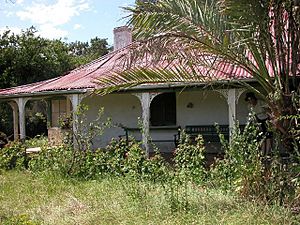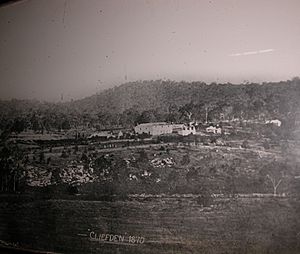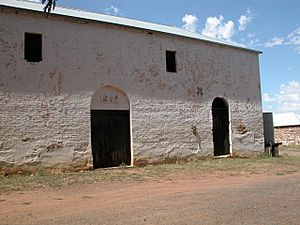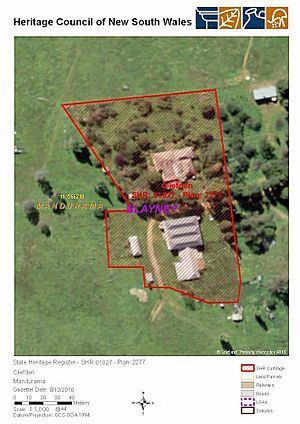Cliefden, Mandurama facts for kids
Quick facts for kids Cliefden |
|
|---|---|

Northern side of the house showing front verandah and 1840s part of the house
|
|
| Location | 1521 Belubula Way, Mandurama, Blayney Shire, New South Wales, Australia |
| Built | 1842– |
| Owner | David Rothery |
| Official name: The Ben Hall Sites - Cliefden; Cleifden Barn | |
| Type | state heritage (built) |
| Designated | 8 October 2010 |
| Reference no. | 1827 |
| Type | Homestead Complex |
| Category | Farming and Grazing |
| Lua error in Module:Location_map at line 420: attempt to index field 'wikibase' (a nil value). | |
Cliefden is a historic homestead located near Mandurama in New South Wales, Australia. It's a special place because it has been owned by the same family, the Rotherys, since 1831. The house and its buildings were built starting in 1842. Cliefden is also famous for its connection to the well-known Australian bushranger, Ben Hall, who raided the property several times in the 1860s. It's now listed on the New South Wales State Heritage Register, meaning it's an important part of the state's history.
Contents
A Glimpse into Cliefden's Past
The story of Cliefden began in 1831 when brothers Frederick John and William Montagu Rothery received land grants. They named their new property Cliefden, after a famous estate in England.
William Montagu Rothery and his wife, Fanny Oceania Lockyer, settled at Cliefden in 1842. They raised 14 children there and also cared for three of William's nephews. The Rothery family has owned Cliefden continuously since 1831, which is a very long time!
The main house and a large barn were built between 1838 and 1842. The house was designed in an "Old Colonial Georgian" style. It originally had at least 26 rooms, plus separate areas for servants. The bricks used to build Cliefden were made right there on the property.
William Rothery was known for raising excellent "blood horses," which were very fast and valuable. The huge barn on the property was built to hold many things. It had stables for horses, a coach house for carriages, a meat-house, and a shearing shed all under one roof.
Ben Hall's Raids
Cliefden became famous for its encounters with the Ben Hall gang. Hall was a well-known bushranger who operated in the area. His gang was especially interested in William Rothery's famous horses.
On 26 September 1863, Hall's gang, dressed in stolen police uniforms, raided Cliefden. They spent about three hours gathering horses and testing them out. They finally chose three horses and two saddles. They also took money, food, and a pair of boots.
Hall and his gang visited Cliefden two more times. On 23 June 1864, Hall was annoyed to find the property well-protected. They only managed to get away with three horses. As they left, Hall set fire to a large haystack and a shed. Cliefden remained well-protected. On 29 November, the gang returned but were scared away by police who were visiting the house.
Cliefden Today
Even today, the homestead and its outbuildings still have many items from the Victorian era. The carriage that brought the Rothery family over the Blue Mountains in 1842 is still in good condition. Until recently, Rothery horses still used the original stalls in the stable section of the barn. Sheep shearing still happens today, using the original pens and exits.
A special wool press, called a Ferrier woolpress, stands in its own large hall in the barn. It's amazing to see this huge machine in such a big, empty space. There's also an old limekiln from the 1830s in a nearby paddock. This kiln helped make the lime needed to build the complex. It's the oldest limekiln over the Blue Mountains.
Exploring Cliefden's Features
The Cliefden farm complex sits on top of a hill. It offers amazing views to the west, north, and east, including a spectacular view of Mount Canobolas. There's also a family cemetery nearby, where generations of Rotherys are buried.
The Homestead
The main house at Cliefden was built as a low brick building in the Colonial Georgian style. It had wide verandahs and very thick walls. It grew bigger over time as the family grew. More rooms were added, especially when the property faced threats from bushrangers.
The front of the house faces north. It has three lovely rooms that open onto the verandah through French doors. The house was designed with a central courtyard. This allowed horses to be brought inside for safety if the homestead was attacked. There was even a special slot built into a wall near an entrance. This allowed someone to fire a weapon at an attacker without being shot themselves.
Outbuildings
The Barn and Woolshed
Close to the house is a large, two-story brick barn and woolshed. The bricks for this impressive building were made on the Cliefden property. It has a unique triple-hipped roof. This huge building, built between 1838 and 1842, holds stables, a coach house, a meat-house, and a shearing shed all under one roof.
The ground floor of the barn has three main areas: stables for horses, wool rooms for sorting and storing wool, and a butcher's shop. The upper floor is used for storage. The actual shearing area is in a timber structure next to the main brick building. Shearing still happens here today.
Boot Maker's Workshop
Near the stables is a small stone building that was once known as the boot maker's workshop. It has been partly rebuilt recently.
People say that two bullet holes can still be seen in a wooden shutter on the western side of the barn. These are believed to be from the Ben Hall gang's raid in 1863. There's also a bell, called the "bushrangers bell," rehung near the old workshop.
The Garden
Cliefden once had a very large garden. You can still see signs of a more formal garden to the north-east of the house, with curved paths. Old photos from the 1870s show big garden areas around the front of the house.
There are also rows of pine trees to the south-west of the house. These trees help protect the house from strong winds. Closer to the house, you can find different types of palm trees. A large red oleander bush near the verandah might even date back to the 1870s.
Why Cliefden is a Heritage Site
Cliefden is very important to the history of New South Wales for several reasons:
- Bushranger History: It shows how bushrangers like Ben Hall attacked private homes and stole valuable horses. Horses were super important for travel back then. Ben Hall's success depended on getting the best horses, and the raids on Cliefden show how skilled he was at choosing them.
- Long Family Ownership: Cliefden has been a working farm since the 1830s, owned by the same family, the Rotherys. This shows a continuous tradition of farming practices over a very long time.
- Fortification Against Attacks: The house itself shows how people tried to protect their homes from bushrangers. The enclosed courtyard and thick walls are examples of these defenses.
- Architectural Style: The Cliefden house and barn are great examples of "Colonial Georgian" architecture. This style was common in early colonial Australia.
- Public Recognition: Cliefden is known by many people as a place connected to Ben Hall. For a while, it was even open for public tours. Ben Hall is a big part of Australian history and identity.
- Archaeological Potential: There might be more hidden information about the original house and how it changed over time. We could also learn more about horse breeding and farming practices from digging around the site.
Cliefden was officially listed on the New South Wales State Heritage Register on 8 October 2010. This means it's recognized as a place of great historical and cultural importance.




